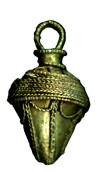A classification of bone, antler, teeth and horn objects from the Early Bronze Age fortified settlement in Maszkowice
DOI:
https://doi.org/10.23858/SA70.2018.013Słowa kluczowe:
Early Bronze Age, Maszkowice, bone and antler industry, traseology, functional analysisAbstrakt
Excavations on the Early Bronze Age fortified settlement in Maszkowice (Western Carpathians) carried out in 1959-1975 and 2010-2017 produced, among other finds, a collection of 56 artifacts made of bone, antler, teeth and horn. They were divided considering formal criteria (size, shape, decoration), as well as a character of use-wear traces into four types of ornaments (plaque, pendants, pins, dress items made of long bones) and seven types of tools (awls, perforators, spatulas, tanning tool, polishers, antler pick and hafted chopping tools). In the description of the types we focus on their functional interpretation, discussing some opinions already existing in the literature. In the final part of paper we analyze also a frequency of distinguished types in the different contexts as well as on the site in general.
Pobrania
Bibliografia
Bátora J. 2000. Das Gräberfeld von Jelšovce/Slowakei. Ein Beitrag zur Frühbronzezeit im nordwestlichen Karpatenbecken 2 (= Prähistorische Archäologie in Südosteuropa 16), Kiel: Verlag Oetker/Voges
Buc N. 2011. Experimental series and use-wear in bone tools, Journal of Archaeological Science 38(3), 546-557
Buc N., Rivero D. and Medina M. 2016. The late Holocene bone tools from Quebrada del Real 1 (Sierras of Córdoba, Argentina). In S. Vitezović (ed.), Close to the bone: current studies in bone technologies, Belgrade: Institute of Archaeology, 80-85
Cabalska M. 1972. Maszkowice, district of Nowy Sącz (A fortified habitation site of the Lusatian culture − the Hallstatt and the Early and Middle La Tène period), Recherches Archéologiques de 1971, 15-20
Cabalska M. 1974. Die Problematik der ältesten, mit Buckelornamentik verzierten Keramik aus dem Gebiete Kleinpolens, unter Berücksichtigung des Materials aus Maszkowice, Kreis Nowy Sącz. In M. Gedl (ed.) Studien zur Lausitzer Kultur (= Prace Archeologiczne 18. Zeszyty Naukowe UJ 352), Kraków: Wydawnictwo Uniwersytetu Jagiellońskiego 57-92
Cabalska M. 1977. Hillfort and fortified settlement of Lusatian Culture in Maszkowice, voivodship of Nowy Sącz, Archaeologia Polona 18, 107-136
Choyke A. 1979. A classification of the bone and antler tools from the Bronze Age hill-fortress of Pákozdvár, Alba Regia 17, 9-21
Choyke A., Vretemark M. and Sten S. 2004. Levels of social identity expressed in the refuse and worked bone from Middle Bronze Age Százhalombatta-Földvár, Vatya culture, Hungary. In S. J. O’Day, W. Van Neer and A. Ervynck (eds.), Behaviour Behind Bones. The zooarchaeology of ritual, religion, status and identity, Oxford: Oxbow Books, 177-189
Diakowski M. 2014. Przedmioty wykonane z kości i poroża. Badania technologiczne i analiza funkcji. In T. Stolarczyk and J. Baron (eds.), Osada kultury pól popielnicowych w Grzybianach koło Legnicy, Legnica-Wrocław: Muzeum Miedzi w Legnicy, 345-392
Drzewicz A. 2004. Wyroby z kości i poroża z osiedla obronnego ludności kultury łużyckiej w Biskupinie, Warszawa: Wydawnictwo Naukowe “Semper”
Gál E. 2011. Prehistoric antler- and bone tools from Kaposújlak-Várdomb (South-Western Hungary) with special regard to the Early Bronze Age implements. In J. Baron and B. Kufel-Diakowska (eds.), Written in Bones. Studies on technological and social contexts of past faunal skeletal remains, Wrocław: Instytut Archeologii Uniwersytet Wrocławski, 137-164
Kadrow S., Machnik J. and Machnikowa A. 1992. Iwanowice, stanowisko Babia Góra: Cmentarzysko z wczesnego okresu epoki brązu, Kraków: Instytut Archeologii i Etnologii PAN
Madyda-Legutko R. 1996. Zróżnicowanie kulturowe polskiej strefy beskidzkiej w okresie lateńskim i rzymskim. Rozprawy Habilitacyjne UJ, 304/1, Kraków: Wydawnictwo Uniwersytetu Jagiellońskiego
Maigrot Y. 2005. Ivory, bone and antler tools production systems at Chalain 4 (Jura, France): late Neolithic site, 3rd millenium. In H. Luik, A. Choyke, C. Batey and L. Lougas (eds.), From Hooves to Horns, from Mollusc to Mammoth: Manufacture and Use of Bone Artefacts from Prehistoric Times to the Present. Proceedings of the 4th Meeting of the ICAZ Worked Bone Research Group at Tallinn, 26th-31st of August 2003, Tallinn: Tallinn Book Printers Ltd, 113-126
Mozsolics A. 1953. Mors en bois de cerf sur le territoire du bassin des Carpathes, Acta Archaeologica Academiae Scientarum Hungaricae 3, 69-204
Olexa L. and Nováček T. 2013. Pohrebisko zo staršej dobry bronzovej v Nižnej Myšli. Katalóg (hroby 1-310), Nitra: Archeologický ústav SAV
Przybyła M. S. 2016. Early Bronze Age stone architecture discovered in Polish Carpathians, Archäologisches Korrespondenzblatt 46(3), 291-308
Przybyła M. S. 2016a. Middle Bronze Age social networks in the Carpathian Basin, Recherches Archéologique NS 8, 47-84
Przybyła M. S. and Jędrysik J. 2017. Recycled fortifications: the Late Bronze and Iron Age settlement in Maszkowice (Western Carpathians). In B. Heeb, A. Szentmiklosi, R. Krause and M. Wemhoff (eds.), Fortifcations: Rise and Fall of Defended Sites In Late Bronze and Early Iron Age Of South-East Europe. Internat. Conference in Timişoara, Romania from November 11th to 13th, 2015 (= Berliner Beiträge zur Vor- und Frühgeschichte 21), Berlin: Staatliche Museen zu Berlin, 91-106
Przybyła M. S. and Skoneczna M. 2011. The fortified settlement from the Early and Middle Bronze Age at Maszkowice, Nowy Sącz district (Western Carpathians). Preliminary results of studies conducted in the years 2009-2012, Recherches Archéologiques NS 3, 5-66
Przybyła M. S. and Skoneczna M. 2014. Bronze Age settlement in Maszkowice (Western Carpathians) – analyses and interpretations. In T. Kienlin, P. Valde-Nowak, M. Korczyńska, K. Cappenberg and J. Ociepka (eds.), Settlement, Communication and Exchange around the Eastern Carpathians in European Context. International Workshop held at the Institute of Archaeology, Jagiellonian University, Kraków, October 27-28, 2012 (= Archaeopress Archaeology), Oxford: Archaeopress, 265-285
Struckmeyer K. 2011. The bone tools from the dwelling mound Feddersen Wierde, Germany, and their functions. In J. Baron and B. Kufel-Diakowska (eds.), Written in Bones. Studies on technological and social contexts of past faunal skeletal remains, Wrocław: Instytut Archeologii Uniwersytet Wrocławski, 187-196
Vitezović S. 2011. The Neolithic Bone Industry from Drenovac, Serbia. In J. Baron and B. Kufel-Diakowska (eds.), Written in Bones. Studies on technological and social contexts of past faunal skeletal remains, Wrocław: Instytut Archeologii Uniwersytet Wrocławski, 117-135
Waszczuk K. 2014. Analiza narzędzi wykonanych z kości, zębów i poroża. In S. Rzepecki, Wilkostowo 23/24. Neolityczny kompleks osadniczy 1. Tekst, Łódź: Instytut Archeologii Uniwersytetu Łódzkiego, Fundacja Uniwersytetu Łódzkiego, 463-470














